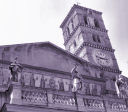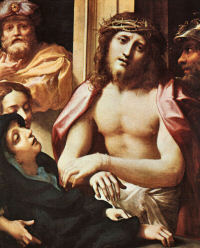Lent: February 29th
Thursday of the Second Week of Lent
Other Commemorations: St. Oswald, Bishop (RM)
» Enjoy our Liturgical Seasons series of e-books!
Today's Station Church is St. Mary in Trastevere, rebuilt in the twelfth century. After St. Mary Major, it is considered the most beautiful church dedicated to Our Lady in Rome.
The thought expressed in today’s first reading in Jeremias is one of the basic themes of the great prophets; it is to be found also in the Psalms (particularly Ps 1) and the book of Proverbs. Trust in men and trust in God—the former belies our expectations and only the latter assures our happiness and enables us to “bring forth good fruit.”
The parable of the rich man and Lazarus, the beggar, is addressed to the Pharisees. The rich man stands for the haughty man who, proudly satisfied with the gifts that God has bestowed on him, is unaware that living as he does he loses God’s favour. The teaching is the same as in the Epistle; blessed are the poor in spirit: those who put their trust in God. —St. Andrew Daily Missal
During Leap Years the Roman Martyrology commemorates on February 29 St. Hilary (d. 468), pope from 461 to 468 and guardian of Church unity and St. Oswald, archbishop of York (925-992) otherwise they are commemorated on February 28.
Meditation—Prayer of Confidence in the Merits and Merciful Power of Jesus
The proud who claim to draw their power form themselves, commit the sin of Lucifer, who said: “I will ascend into Heaven…. I will be like the Most High”; like Lucifer they will be overthrown and cast down into the abyss.
But what do we say? That without Christ, we can do nothing, as He has Himself declared. We declare that it is through Jesus, with Jesus, that we can arrive at holiness and enter into Heaven; we say to Christ: “Master, I am poor, miserable, naked, weak, of this I am daily more and more convinced. But I know, too, that Thou art ineffably powerful, great and good; I know that the Father Thou lovest so much hath placed in Thee all the treasures of holiness that men may desire; I know that Thou wilt never reject those who come to Thee. Therefore, whilst adoring Thee in the deepest recesses of my soul, I have full confidence in Thy merits and satisfactions; I know that, altogether miserable as I am, Thou canst, by Thy grace, shower Thy riches upon me, uplift me even to the Divine, that I may be made like unto Thee and may share in Thy Divine Beatitude!”
—Dom Columba Marmion, Christ the Ideal of the Monk
St. Oswald of Worcester
St. Oswald was born of a Danish family that settled in England. He was educated by his uncle St. Odo, bishop of Canterbury, was appointed dean of Winchester, and soon after sent by Odo to the abbey of Fleury in France to learn monastic discipline.
In 962, Oswald succeeded St. Dunstan as bishop of Worcester, and he was closely associated with Dunstan and St. Ethelwold in the restoration of monasticism in England. His first foundation was at Westbury-on-Trym near Bristol, but his greatest establishment was at Ramsey in Huntingdonshire (972), from which were founded Pershore, Evesham, and other houses.
St. Oswald shone as a bright star as bishop. He was energetic in improving the standard of the parochial clergy, fostering education, and enforcing clerical celibacy, and in 972 he was promoted to archbishop of York, where as a young man he had worked under his uncle Archbishop Oskitell (Oskytel). But he was obliged to retain the see of Worcester as well, presiding over both dioceses; it is with Worcester that he was always concerned.
St. Oswald was almost always occupied in visiting his diocese, preaching without intermission, and reforming abuses. He encouraged learning and learned men. When not engaged in pastoral duties, Oswald could be found joining the monks of St. Mary's monastery in their exercises.
To nourish his own humility and charity, Oswald always invited 12 of the poor to dine with him each day during Lent (some say every day). These he served himself, and also washed and kissed their feet. He died at St. Mary's just after fulfilling this Lenten observance and after receiving the viaticum, while repeatedly praying the Glory Be.
His body was translated by his successor Adulph ten years later and enshrined. Still later his relics were transferred to York.
—Adapted from Celtic Saints
Symbols and Representation: church; demon; dove; ship; stone
Highlights and Things to Do:
- Read more about St. Oswald:
- St. Oswald's remains are located in the Worcester Cathedral.
 Thursday of the Second Week of Lent
Thursday of the Second Week of Lent
Station with Santa Maria in Trastevere (St. Mary in Trastevere ):
The Station for today is in the celebrated basilica, St. Maria in Trastevere. The basilica was consecrated in the third century, under the pontificate of St. Callixtus, and was the first church built in Rome in honor of our Blessed Lady, particularly for her Assumption. The original church was demolished and the current church was constructed between 1139 to 1181, with additions such as mosaics and chapels added through the centuries.
For more on Santa Maria in Trastevere, see:
For further information on the Station Churches, see The Stational Church.






